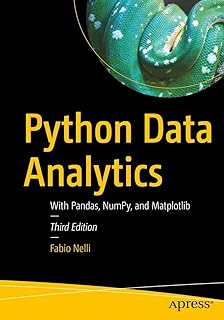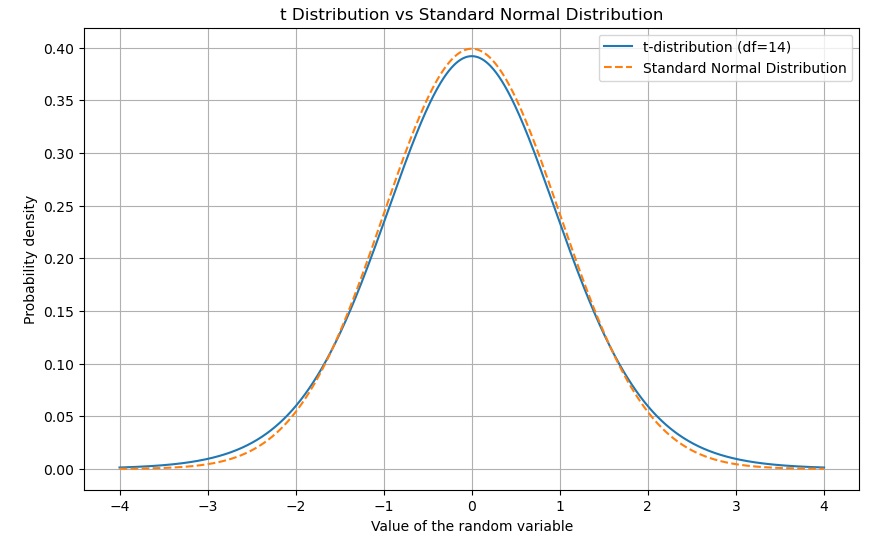
The Student’s t-distribution is a probability distribution that derives from the concept of t-statistics. It is often used in statistical inference when the sample on which an analysis is based is relatively small and the population standard deviation is unknown. The shape of the t distribution is similar to the normal one, but has thicker tails, making it more suitable for small sample sizes.
This distribution is widely used in t-tests and confidence intervals, especially when it comes to estimates of the population mean. The exact shape of the t distribution depends on the degrees of freedom, which are determined by the sample size. As the degrees of freedom increase, the t-distribution gets closer and closer to a standard normal distribution.
[wpda_org_chart tree_id=11 theme_id=50]
Student’s t distribution
The Student’s t distribution is obtained by introducing a correction for additional variability due to small sample sizes when estimating the population standard deviation.
The basic idea is linked to the concept of t-statistics, which is given by:
![]()
where:
 is the sample mean,
is the sample mean, is the population average,
is the population average, is the sample standard deviation,
is the sample standard deviation, is the sample size.
is the sample size.
The distribution of this t-statistic follows the Student’s t-distribution. The exact shape of the t distribution depends on the degrees of freedom ![]() , which are calculated as
, which are calculated as ![]() , where
, where ![]() is the sample size.
is the sample size.
As the degrees of freedom increase, the t distribution approaches the standard normal distribution. This means that as the sample size increases, the correction for sample size becomes less critical, and the t-distribution behaves more and more like a normal distribution.

If you want to delve deeper into the topic and discover more about the world of Data Science with Python, I recommend you read my book:
Fabio Nelli
Using Student’s t-distribution
The Student’s t distribution is commonly used in various contexts, especially when working with small sample sizes or when the population standard deviation is unknown. Here are some concrete examples:
- t-test for a single mean:
Suppose we have a small sample of size 10 and we want to test whether the sample mean is significantly different from a certain theoretical mean.
- t-test for differences between two means:
When we compare two groups with small sample sizes and want to determine whether their means are significantly different.
- Confidence interval for the mean:
Calculate a confidence interval to estimate the population mean, especially when the population standard deviation is unknown.
- Linear Regression:
In cases where a linear regression is performed with a small number of observations, tests of the significance of the coefficients may involve the t-distribution.
- Analysis of variance (ANOVA):
When we compare the means of more than two groups and the sample sizes are small, the t-distribution may be involved in evaluating the significance of differences between groups.
In essence, the t-distribution is a valuable tool when you are working with small sample sizes and want to make inferences about the population from which the samples come.
Example of using Student’s t
Let’s consider an example where we want to calculate the t-distribution for a single-mean t-test. Suppose we have a sample of size 15 and we want to test whether the mean of this sample is significantly different from 10. The mean of the sample ![]() is 9, the standard deviation of the sample latex[/latex] is 2.5.
is 9, the standard deviation of the sample latex[/latex] is 2.5.
Calculating the t-statistic:![]()
![]()
Calculation of degrees of freedom:![]()
Now we can look at the Student’s t-distribution table or use statistical software to get the p-value associated with ![]() and
and ![]() . Suppose we get a p-value of
. Suppose we get a p-value of ![]() .
.
You can use the scipy.stats module in Python to perform the t-statistic calculation and get the p-value. Here is a sample Python code for the example we discussed:
import numpy as np
from scipy import stats
# Sample data
sample_mean = 9
population_mean = 10
sample_std = 2.5
sample_size = 15
# Calculation of the t-statistic
t_statistic = (sample_mean - population_mean) / (sample_std / np.sqrt(sample_size))
# Calculation of degrees of freedom
degrees_of_freedom = sample_size - 1
# Calculation of the p-value
p_value = 2 * stats.t.cdf(t_statistic, df=degrees_of_freedom)
# Printing of results
print(f"t-statistics: {t_statistic}")
print(f"Degrees of freedom: {degrees_of_freedom}")
print(f"P-value: {p_value}")Executing you will get the following result:
t-statistics: -1.5491933384829668
Degrees of freedom: 14
P-value: 0.1436400002452211Make sure you have the scipy module installed. You can install it using:
pip install scipyThis code calculates the t-statistic, degrees of freedom and the associated p-value. Remember that the p-value is the probability of getting a result at least as extreme as the observed one, assuming that the null hypothesis (in our case, that the means are equal) is true. If the p-value is less than the chosen significance level (for example, 0.05), we can reject the null hypothesis.
We can graph the t-distribution using a density plot of the t-distribution. The shape of the t distribution will depend on the degrees of freedom. Due to its bell shape and thicker tails than a normal one, the t-distribution will be different based on the degrees of freedom. For example, we could draw the t-distribution with 14 degrees of freedom and overlay it on a standard normal to show the differences in the tails. normal ribution.
You can use the matplotlib module to visualize distributions. Here is a sample code that creates a graph of the t-distribution with 14 degrees of freedom and overlays it on a standard normal distribution:
import numpy as np
import matplotlib.pyplot as plt
from scipy.stats import t, norm
# Degrees of freedom
degrees_of_freedom = 14
# Generate data for the t-distribution
x = np.linspace(-4, 4, 1000)
y_t = t.pdf(x, df=degrees_of_freedom)
# Generates data for the standard normal distribution
y_norm = norm.pdf(x)
# Create the chart
plt.figure(figsize=(10, 6))
plt.plot(x, y_t, label=f't-distribution (df={degrees_of_freedom})')
plt.plot(x, y_norm, label='Standard Normal Distribution', linestyle='dashed')
plt.title('t Distribution vs Standard Normal Distribution')
plt.xlabel('Value of the random variable')
plt.ylabel('Probability density')
plt.legend()
plt.grid(True)
plt.show()This code creates a graph showing the t-distribution with 14 degrees of freedom and overlays it on a standard normal distribution (dotted line). You can see how the tails of the t-distribution are thicker than those of the standard normal distribution.

